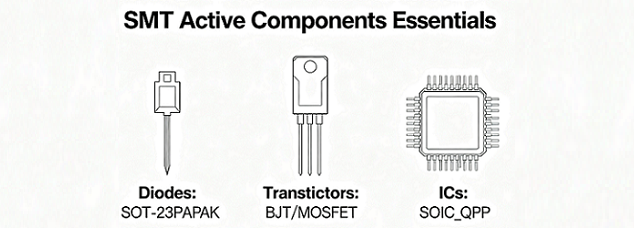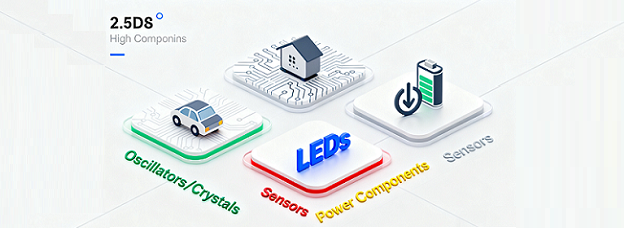Surface Mount Technology has revolutionized electronics manufacturing, enabling the making of smaller, more efficient, high-performance devices. As one of the leading PCB solutions providers, PCBCart finds it important to realize that knowing the different types of SMT components will be critical in the design and assembly of reliable circuits. Each class, from the basic passive component to the advanced active device, has a special role in powering modern electronics. A breakdown of key SMT component categories follows.

Passive SMT Components
Passive components in the electronic circuit are basic, not capable of amplification and working essentially for current regulation, energy storage, and noise filtering. Normally, they are smaller in size, inexpensive, and are extensively used in large-scale production.

Resistors
Resistors come in various values that limit electric current flow, measured in ohms (Ω). Common types of SMT resistors include thin-film resistors, which have high precision for instrumentation at 0.01% tolerance; thick-film resistors, which are general-purpose, low-cost resistors at 1-5% tolerance; and current sense resistors, which usually have low resistance (<1Ω) to measure current. The most common sizes include 0402 (1.0x0.5mm), 0603 (1.5x0.8mm), and 0805 (2.0x1.3mm), among others. Resistance values are denoted by an alphanumeric code; for example, "103" means 10kΩ.
Capacitors
Capacitors store and release electrical energy. Their value, called capacitance, is measured in farads (F). Common units include µF, nF, and pF. Key SMT types include ceramic multilayer capacitors (MLCCs, non-polarized, inexpensive for general-purpose work), tantalum capacitors (high capacitance-to-volume ratio, polarized, suitable for power supplies), film capacitors (high precision for RF and audio circuits), and electrolytic capacitors (high capacitance for power management). They have the same outline sizes as resistors. Capacitors use the same three-digit code, but one that represents picofarads: for example, "104" = 100 nF.
Inductors
Inductors store energy in magnetic fields (measured in henries) and are crucial for filtering out high-frequency noise and power conversion. SMT inductors come in wire-wound variants, which provide high inductance and high current handling, and multilayer variants, which provide compact, high-density solutions. Ferrite bead inductors are special types to suppress high-frequency interference. Standard sizes align with resistor/capacitor formats, while four-digit codes denote inductance values, such as "1002" = 1mH.
Fuses
SMT fuses protect circuits against overcurrent and surges. Types include resettable polymeric PTC fuses, which are self-recovering after overload, and standard melting fuses for permanent circuit breakage in case of severe faults. Their surface-mount design provides automated assembly while keeping reliable protection for consumer electronics and industrial devices.
Active SMT Components
Active components amplify signals, switch currents, or process data by using semiconductor technology to deliver complicated functionality. They constitute the "brains" of electronic circuits, enabling advanced operations such as signal processing or power management.

Diodes
It allows one-way flow of current, with specialized types for different uses. Rectifier diodes serve in power supplies for AC to DC conversion, Schottky diodes provide fast switching in RF circuits, Zener diodes are used for voltage regulation, while SMD LEDs emit light for use in indicators or lighting. The most popular packages are SOT-23 (3.0x1.75x1.3mm) for small-signal versions and DPAK (6.5x2.25x10.2mm) for high-power variants.
Transistors
Transistors are electronic devices that amplify or switch electronic signals and are considered some of the basic building blocks in both digital and analog circuits. BJTs of NPN/PNP type are noted for their use in linear amplification, while field-effect transistors consist of JFETs, characterized by low noise and high input impedance, and MOSFETs, showing high-speed switching with minimum power dissipation. MOSFETs are again categorized into enhancement-mode (normally off) and depletion-mode (normally on) types, finding wide applications in power supply and microprocessor circuits.
Integrated Circuits (ICs)
ICs integrate hundreds to millions of components, such as transistors, resistors, and diodes, on a single chip to enable complicated functionalities. Digital ICs such as microprocessors, microcontrollers, and DSPs process digital data for computers and smartphones. Analog ICs comprising op-amps and voltage regulators deal with continuous signals for audio amplifiers and sensors. Mixed-signal ICs combine digital and analog circuits in converters for data and RF devices, and power management ICs manage voltage and provide power distribution in gadgets like laptops and electric vehicles. Common packages comprise SOIC (gull-wing pins), QFP (quad-flat package), and BGA (ball grid array, high-density interconnects).
Specialized SMT Components
Such components serve niche applications, including very specific needs for timing, wireless communication, and environmental sensing.

LEDs
SMT LEDs are compact light sources, from tiny status indicators to high-power lighting modules. Many include integral lenses or multi-color packages and are ideal for displays, automotive lighting, and consumer electronics.
Oscillators and Crystals
These provide stable timing references for circuits. SMT crystals are simple resonators in small ceramic packages, while oscillator modules integrate full circuitry for reliable clock signals, critical for microprocessors and communication devices.
RF Components
RF inductors, filters, baluns, and antennas are designed for high-frequency applications. The surface-mount format minimizes lead length to reduce parasitic effects degrading performance in wireless devices such as routers and smartphones.
Sensors
SMT sensors have become a fast-growing category that includes temperature sensors, accelerometers, gyroscopes, and environmental sensors, including humidity and gas. These provide sensing elements and processing circuitry in compact packages that enable smart devices and IoT applications.
Power Components
Examples are voltage regulators, DC-DC converters, and power management ICs operating with high currents and thermal loads. Many of these feature exposed pads for heat dissipation via the PCB to ensure reliability in power-hungry devices like servers and electrical vehicles.
Conclusion
Understanding component types is key to designing efficient, reliable electronic circuits using SMT. From simple, passive resistors and capacitors to high-tech ICs and sensors, each component plays its role in shaping today's technology. Here at PCBCart, we use our knowledge of SMT assembly to help customers make the best choices for their applications-developing compatible, performance-maximizing, and budget-friendly assemblies. Be it consumer electronics, industrial equipment, or an IoT device, the latest manufacturing capabilities and technical support at every stage ensure seamless integration of SMT components into your PCB.






